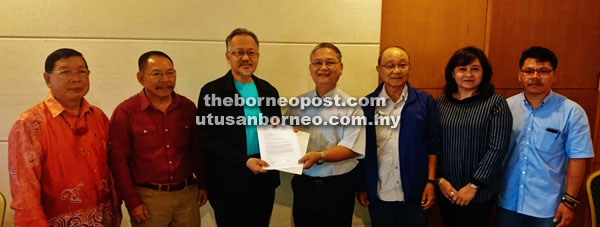
Kallang (fourth right) handing over the draft copy of the pre-proposal for a community initiated land and environmental conservation initiative in Ulu Baram to Sapuan in the presence of (from left) James Nyuran from the Kenyah community in Baram, Komeok, Paul Chai, who is the ITTO project leader for Sarawak, Zarina Shabli, who is the officer for the Conservation of Forest and Siah representing the Penan community from Baram.
KUCHING: The draft of the pre-proposal for a community initiated land and environmental conservation initiative in Ulu Baram has the support of Sarawak Forest Department.
Forest Department director Sapuan Ahmad received the document from the community at a simple ceremony at a hotel in Miri recently.
The ceremony was attended by representatives from SAVE Rivers led by its chairman Peter Kallang and the Keruan
Organisation led by its chairman Komeok Joe.
The proposed area is located in the north-eastern part of Sarawak, mostly in Upper Baram region while some small parts are at the sources of Tutoh and Akah rivers.
Those within the area are more than 4,000 people from 32 villages of Orang Ulu ethnic groups of Penan, Kenyah, Saban and Kelabit. The approach proposed for the affected area is for a co-management strategy, where the villagers and the government will work together for sustainable development and conservation.
The size of the proposed zone is 283,500 hectares, out of which 28 per cent or 79,000 hectares are still covered with primary forest and being proposed to be protected as ‘core zone’ while 23 per cent of the area are previous and current agricultural land classified as ‘Agriculture Zone’.
The remaining 49 per cent is classified as ‘Buffer Zone’ dedicated to sustainable development, conservation and forest restoration projects, creating local income and socio-economic development.
Commenting on the draft Pre-Proposal, Sapuan said: “At the department level, we welcome and support the proposal and we will study it.
“After that, we will give you feedback on it and we can assist where appropriate. I suggest that you give your final
proposal by the second half of this year.”
Komeok, who is just back from leading a team from the Forest Department to the proposed areas, said he was happy to see the positive response from the government and hoped that the proposal would be approved speedily.
He added: “This is the wish of the people from the areas and it is for the people… they are from various indigenous groups. It is for everyone’s good.”
Kallang from SAVE Rivers commented: “This approach allows conservation and sustainable development to be achieved. It is focused on three main aspects, which are social, economy and the environment.”
“Based on the World Commission on Environment and Development’s definition, sustainable development is ‘development that meets the needs of the present without compromising the ability of future generations to meet their own needs’,” he said.
